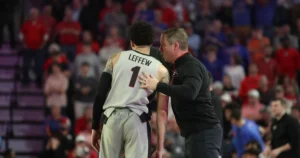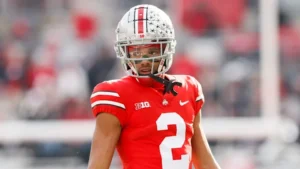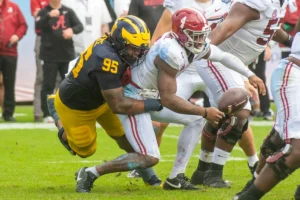
Another Bulldog Bites the Dust: Chris Peal Enters Transfer Portal
In a move that underscores the fluidity of college football rosters in the modern era, University of Georgia defensive back Chris Peal has officially entered the NCAA transfer portal. The announcement, made public earlier today, marks the latest departure from the traditionally stout Bulldogs program during the spring transfer window, which opened on Wednesday, April 16th, and is set to close on Friday, April 25th. Peal, a former highly-touted four-star recruit from the 2023 class, becomes the fourth Bulldog to enter the portal during this current 10-day window, joining running back Branson Robinson, wide receiver Nitro Tuggle, and offensive lineman Marques Easley in seeking new opportunities.
Hailing from Providence Day School in Charlotte, North Carolina, Peal arrived in Athens with considerable expectations. Ranked among the top players nationally in his class, he chose Georgia over a host of other prominent programs, including South Carolina, NC State, and Michigan. Standing at an imposing 6-foot-1 and weighing around 190 pounds, Peal possessed the coveted blend of size and athleticism that modern defensive coordinators covet in a cornerback. His recruitment was a significant victory for Kirby Smart and his coaching staff, further solidifying Georgia’s reputation as a recruiting powerhouse.
However, Peal’s tenure in Athens did not unfold as many might have anticipated. He redshirted during his true freshman season in 2023, a common practice for developing players within a program as talent-rich as Georgia. In the subsequent 2024 season, Peal saw limited action, appearing in just four games as a reserve in the Bulldogs’ secondary. While game experience is invaluable for young players, the scarcity of opportunities likely played a role in Peal’s decision to explore other avenues.
Sources close to the Georgia program had indicated that Peal was making significant strides during the recent spring practices. There were even whispers that he was competing for a starting cornerback role alongside talented underclassmen Ellis Robinson IV and Daniel Harris, with some reports suggesting he was outperforming his peers at times. This makes his decision to enter the transfer portal somewhat surprising, as it suggests a potential disconnect between his perceived progress and the actual pathway to significant playing time within the Bulldogs’ deep defensive backfield.
Peal’s departure represents a notable loss of potential for Georgia. While the Bulldogs boast a consistently high level of talent, depth at every position is crucial for navigating the rigors of a Southeastern Conference schedule and a potential College Football Playoff run. The fact that Peal was reportedly pushing for a starting role indicates the level of talent he possessed, and his exit creates a void in terms of experienced depth at the cornerback position.
Head coach Kirby Smart and his staff will now need to assess the impact of Peal’s decision on their secondary heading into the 2025 season. While Robinson IV and Harris remain key figures, the coaching staff may now look to other players on the roster to step up and provide reliable depth. Additionally, the Bulldogs have been active in the transfer portal themselves, adding players at other positions of need. It remains to be seen whether they will now turn their attention to potentially adding a veteran cornerback through the portal to bolster their secondary.
For Chris Peal, the transfer portal offers a chance to find a program where he can secure a more prominent role and showcase his abilities. As a former four-star recruit with two years of college experience, including a redshirt season, he will undoubtedly be a sought-after commodity in the transfer market. Several schools have already been mentioned as potential landing spots, including Michigan State, Syracuse (where former Georgia defensive backs coach Fran Brown is now the head coach), and Oregon. The opportunity to become a key contributor for a program could be the catalyst needed for Peal to realize his considerable potential.
The NCAA transfer portal has become an increasingly influential factor in college football roster management. Since the implementation of the one-time transfer exception in 2021, which allows undergraduate student-athletes to transfer once without having to sit out a year of competition, player movement has surged. This has empowered athletes to seek out programs that better fit their playing aspirations, academic goals, or personal preferences. The portal operates within specific windows, with the spring window providing an opportunity for players to make moves after spring practices and before the start of the summer training period.
For programs like Georgia, the transfer portal presents a double-edged sword. While it can lead to the departure of talented players seeking more playing time, it also offers an avenue to address immediate needs on the roster by bringing in experienced players from other schools. The ability to quickly reshape a roster through strategic portal additions has become a crucial element of modern college football success.
The impact of the transfer portal on the sport is multifaceted. It has undoubtedly increased player mobility and provided greater autonomy for student-athletes. Players who find themselves in unfavorable situations, whether due to playing time, coaching changes, or academic misalignment, now have a viable pathway to seek better opportunities. Moreover, the portal can act as a form of free agency for college athletes, allowing them to leverage their talent and potential for potentially better playing situations and even enhanced Name, Image, and Likeness (NIL) opportunities.
However, the transfer portal also presents challenges for college football programs. It can lead to significant roster turnover, making it more difficult to build long-term program continuity and develop a cohesive team culture. Coaches must now constantly balance the need to develop their existing players with the potential to upgrade their roster through portal additions. The constant flux of players can also strain team dynamics and create challenges in maintaining team chemistry.
Academically, frequent transfers can also pose challenges for student-athletes. Transferring between institutions can often lead to the loss of academic credits, potentially delaying graduation and disrupting a student’s academic progress. Navigating different academic requirements and course equivalencies can be a complex process for transferring student-athletes.
The combination of the transfer portal and NIL has further complicated the landscape of college football. The ability for players to earn compensation for their NIL has become a significant factor in recruiting and transfer decisions. Programs with strong NIL collectives may have an advantage in attracting and retaining top talent, potentially widening the competitive gap between larger and smaller programs.
In conclusion, Chris Peal’s decision to enter the transfer portal is a significant development for both the player and the Georgia Bulldogs. For Peal, it represents a chance to find a program where he can potentially play a more significant role and showcase the talent that made him a highly-regarded recruit. For Georgia, it means the departure of a promising defensive back and necessitates an evaluation of their depth in the secondary moving forward. As the transfer portal continues to reshape college football, stories like Peal’s have become increasingly common, highlighting the ever-evolving dynamics of roster construction in the modern game. The spring transfer window remains open for a few more days, and it will be intriguing to see if Georgia makes any further additions or if any other players decide to seek new opportunities before the deadline. The impact of these moves will undoubtedly shape the landscape of college football as teams prepare for the 2025 season.





